-

新人教版高中英语选修2Unit 2 Learning about Language教学设计
The activity theme of this section is to design various activities around the key words in the first text. Therefore, the activities require students to pay attention to the spelling of words. On the other hand, let students grasp the meaning of words more accurately through sentences and short texts. This kind of teaching design also helps to improve the ability of using English thinking.1. Cultivating students' ability to use word formation to induce and memorize vocabulary, and the ability to use lexical chunks to express meaning.2. Guide the students to think independently and use the correct form of words to complete sentences3. Cultivate students' habit of using lexical chunks to express language completely, guide students to draw words in sentences quickly, pay attention to word collocation, so as to accumulate more authentic expressions4. Instruct students to create sentences with the chunks.1. Enable students to use the language points in the real situation or specific contexts flexibly and appropriately.2. Guiding the Ss to use unit topic words and the sentence patterns in a richer context.Step1: Think of a word that best fits each definition.1. to remember sth2.to accept, admit, or recognize sth or the truth/existence of sth3. the process of changing sth or yourself to suit a new situation4 .to make sb feel less worried or unhappy5. a strong desire to achieve sth

新人教版高中英语选修2Unit 2 Reading and thinking教学设计
Her tutor told her to acknowledge __________ other people had said if she cited their ideas, and advised her _______(read) lots of information in order to form __________wise opinion of her own.Now halfway __________ her exchange year, Xie Lei felt much more at home in the UK. She said __________ (engage) in British culture had helped and that she had been__________ (involve) in social activities. She also said while learning about business, she was acting as a cultural messenger __________(build) a bridge between the two countries. keys:Xie Lei, a 19yearold Chinese student, said goodbye to her family and friends in China and boarded (board) a plane for London six months ago in order to get a business qualification. She was ambitious(ambition) to set up a business after graduation. It was the first time that she had left (leave) home.At first, Xie Lei had to adapt to life in a different country. She chose to live with a host family, who can help with her adaptation (adapt) to the new culture. When she missed home, she felt comforted (comfort) to have a second family. Also Xie Lei had to satisfy academic requirements. Her tutor told her to acknowledge what other people had said if she cited their ideas, and advised her to read lots of information in order to form a wise opinion of her own.Now halfway through her exchange year, Xie Lei felt much more at home in the UK. She said engaging (engage) in British culture had helped and that she had been involved (involve) in social activities. She also said while learning about business, she was acting as a cultural messenger building a bridge between the two countries.

新人教版高中英语选修2Unit 2 Reading for writing教学设计
The theme of this section is to express people's views on studying abroad. With the continuous development of Chinese economic construction, especially the general improvement of people's living standards, the number of Chinese students studying abroad at their own expense is on the rise. Many students and parents turn their attention to the world and regard studying abroad as an effective way to improve their quality, broaden their horizons and master the world's advanced scientific knowledge, which is very important for the fever of going abroad. Studying abroad is also an important decision made by a family for their children. Therefore, it is of great social significance to discuss this issue. The theme of this section is the column discussion in the newspaper: the advantages and disadvantages of studying abroad. The discourse is about two parents' contribution letters on this issue. They respectively express their own positions. One thinks that the disadvantages outweigh the advantages, and the other thinks that the advantages outweigh the disadvantages. The two parents' arguments are well founded and logical. It is worth noting that the two authors do not express their views on studying abroad from an individual point of view, but from a national or even global point of view. These two articles have the characteristics of both letters and argumentative essays1.Guide the students to read these two articles, and understand the author's point of view and argument ideas2.Help the students to summarize the structure and writing methods of argumentative writing, and guides students to correctly understand the advantages and disadvantages of studying abroad3.Cultivate students' ability to analyze problems objectively, comprehensively and deeply

新人教版高中英语选修2Unit 3 Using langauge-Listening教学设计
1. How is Hunan cuisine somewhat different from Sichuan cuisine?The heat in Sichuan cuisine comes from chilies and Sichuan peppercorns. Human cuisine is often hotter and the heat comes from just chilies.2.What are the reasons why Hunan people like spicy food?Because they are a bold people. But many Chinese people think that hot food helps them overcome the effects of rainy or wet weather.3.Why do so many people love steamed fish head covered with chilies?People love it because the meat is quite tender and there are very few small bones.4.Why does Tingting recommend bridge tofu instead of dry pot duck with golden buns?Because bridge tofu has a lighter taste.5 .Why is red braised pork the most famous dish?Because Chairman Mao was from Hunan, and this was his favorite food.Step 5: Instruct students to make a short presentation to the class about your choice. Use the example and useful phrases below to help them.? In groups of three, discuss what types of restaurant you would like to take a foreign visitor to, and why. Then take turns role-playing taking your foreign guest to the restaurant you have chosen. One of you should act as the foreign guest, one as the Chinese host, and one as the waiter or waitress. You may start like this:? EXAMPLE? A: I really love spicy food, so what dish would you recommend?? B: I suggest Mapo tofu.? A: Really ? what's that?

新人教版高中英语选修2Unit 4 Learning about Language教学设计
This section guides students to pay attention to the typical context of vocabulary use, helps students accumulate vocabulary around the key vocabulary of this unit, and uses the learned words and word chunks in different contexts to deeply understand their meaning and usage, so as to achieve the purpose of review and consolidation.The teaching design activities aim to guide students to pay attention to the typical context in which the target vocabulary is used, as well as the common vocabulary used in collocation, so that students can complete the sentence with correct words. In terms of vocabulary learning strategies, this unit focuses on cultivating students' ability to pay attention to collocation of words and to use word blocks to express meaning.For vocabulary learning, it is not enough just to know the meaning of a single word, but the most important thing is to master the common collocations of words, namely word blocks.Teachers should timely guide students to summarize common vocabulary collocation, such as verb and noun collocation, verb and preposition collocation, preposition and noun collocation, and so on.1. Guide students to understand and consolidate the meaning and usage of the vocabulary in the context, 2. Guide the students to use the unit topic vocabulary in a richer context3. Let the students sort out and accumulate the accumulated vocabulary, establishes the semantic connection between the vocabulary,4. Enable students to understand and master the vocabulary more effectivelyGuiding the Ss to use unit topic words and the sentence patterns in a richer context.

新人教版高中英语选修2Unit 5 Using langauge-Listening教学设计
The theme of this section is to learn how to make emergency calls. Students should learn how to make emergency calls not only in China, but also in foreign countries in English, so that they can be prepared for future situations outside the home.The emergency telephone number is a vital hotline, which should be the most clear, rapid and effective communication with the acute operator.This section helps students to understand the emergency calls in some countries and the precautions for making emergency calls. Through the study of this section, students can accumulate common expressions and sentence patterns in this context. 1.Help students accumulate emergency telephone numbers in different countries and learn more about first aid2.Guide the students to understand the contents and instructions of the telephone, grasp the characteristics of the emergency telephone and the requirements of the emergency telephone.3.Guide students to understand the first aid instructions of the operators.4.Enable Ss to make simulated emergency calls with their partners in the language they have learned1. Instruct students to grasp the key information and important details of the dialogue.2. Instruct students to conduct a similar talk on the relevant topic.Step1:Look and discuss:Match the pictures below to the medical emergencies, and then discuss the questions in groups.
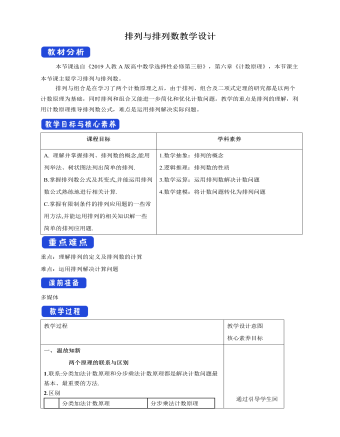
人教版高中数学选修3排列与排列数教学设计
4.有8种不同的菜种,任选4种种在不同土质的4块地里,有 种不同的种法. 解析:将4块不同土质的地看作4个不同的位置,从8种不同的菜种中任选4种种在4块不同土质的地里,则本题即为从8个不同元素中任选4个元素的排列问题,所以不同的种法共有A_8^4 =8×7×6×5=1 680(种).答案:1 6805.用1、2、3、4、5、6、7这7个数字组成没有重复数字的四位数.(1)这些四位数中偶数有多少个?能被5整除的有多少个?(2)这些四位数中大于6 500的有多少个?解:(1)偶数的个位数只能是2、4、6,有A_3^1种排法,其他位上有A_6^3种排法,由分步乘法计数原理,知共有四位偶数A_3^1·A_6^3=360(个);能被5整除的数个位必须是5,故有A_6^3=120(个).(2)最高位上是7时大于6 500,有A_6^3种,最高位上是6时,百位上只能是7或5,故有2×A_5^2种.由分类加法计数原理知,这些四位数中大于6 500的共有A_6^3+2×A_5^2=160(个).

人教版高中数学选修3条件概率教学设计
(2)方法一:第一次取到一件不合格品,还剩下99件产品,其中有4件不合格品,95件合格品,于是第二次又取到不合格品的概率为4/99,由于这是一个条件概率,所以P(B|A)=4/99.方法二:根据条件概率的定义,先求出事件A,B同时发生的概率P(AB)=(C_5^2)/(C_100^2 )=1/495,所以P(B|A)=(P"(" AB")" )/(P"(" A")" )=(1/495)/(5/100)=4/99.6.在某次考试中,要从20道题中随机地抽出6道题,若考生至少答对其中的4道题即可通过;若至少答对其中5道题就获得优秀.已知某考生能答对其中10道题,并且知道他在这次考试中已经通过,求他获得优秀成绩的概率.解:设事件A为“该考生6道题全答对”,事件B为“该考生答对了其中5道题而另一道答错”,事件C为“该考生答对了其中4道题而另2道题答错”,事件D为“该考生在这次考试中通过”,事件E为“该考生在这次考试中获得优秀”,则A,B,C两两互斥,且D=A∪B∪C,E=A∪B,由古典概型的概率公式及加法公式可知P(D)=P(A∪B∪C)=P(A)+P(B)+P(C)=(C_10^6)/(C_20^6 )+(C_10^5 C_10^1)/(C_20^6 )+(C_10^4 C_10^2)/(C_20^6 )=(12" " 180)/(C_20^6 ),P(E|D)=P(A∪B|D)=P(A|D)+P(B|D)=(P"(" A")" )/(P"(" D")" )+(P"(" B")" )/(P"(" D")" )=(210/(C_20^6 ))/((12" " 180)/(C_20^6 ))+((2" " 520)/(C_20^6 ))/((12" " 180)/(C_20^6 ))=13/58,即所求概率为13/58.
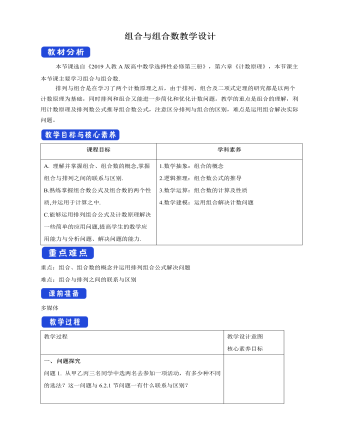
人教版高中数学选修3组合与组合数教学设计
解析:因为减法和除法运算中交换两个数的位置对计算结果有影响,所以属于组合的有2个.答案:B2.若A_n^2=3C_(n"-" 1)^2,则n的值为( )A.4 B.5 C.6 D.7 解析:因为A_n^2=3C_(n"-" 1)^2,所以n(n-1)=(3"(" n"-" 1")(" n"-" 2")" )/2,解得n=6.故选C.答案:C 3.若集合A={a1,a2,a3,a4,a5},则集合A的子集中含有4个元素的子集共有 个. 解析:满足要求的子集中含有4个元素,由集合中元素的无序性,知其子集个数为C_5^4=5.答案:54.平面内有12个点,其中有4个点共线,此外再无任何3点共线,以这些点为顶点,可得多少个不同的三角形?解:(方法一)我们把从共线的4个点中取点的多少作为分类的标准:第1类,共线的4个点中有2个点作为三角形的顶点,共有C_4^2·C_8^1=48(个)不同的三角形;第2类,共线的4个点中有1个点作为三角形的顶点,共有C_4^1·C_8^2=112(个)不同的三角形;第3类,共线的4个点中没有点作为三角形的顶点,共有C_8^3=56(个)不同的三角形.由分类加法计数原理,不同的三角形共有48+112+56=216(个).(方法二 间接法)C_12^3-C_4^3=220-4=216(个).

高中生抗战胜利70周年国旗下讲话稿
尊敬的各位老师,亲爱的同学们:早上好!三天前,在北京举行了盛大的纪念反法西斯抗战胜利70周年的阅兵式,大家也都亲自感受到了那气势恢宏、震撼人心的场景。从今天开始,大家要踏上训练场,体验一下当兵的生活!有同学说训练很苦,我却想告诉大家。今天,我们能在和平的年代进行军训,就是一种幸福。70年前的那场浩劫,中国军民死伤达3500万以上,9500万平民沦为难民,中国近多半的领土被日军的铁蹄蹂躏八年之久。很庆幸,我们没有生活在那个时代,而是生活在现在这样一个和平、繁盛的时期,我们有什么理由去抱怨,有什么借口挥霍现在的日子。我们所要做的就是珍惜现在,感恩那些为我们创造了这个时代的所有人。早晨,大家睁开惺忪睡眼,沐浴着晨光踏上训练场,你要感恩身边没有炮火,没有枪声,一切都是那样安静与祥和。当你挺直腰杆,聆听着教官讲解动作要点,你应该感恩没有奔波,没有衣食之忧,一切都是如此和谐与静谧。

第十七周国旗下讲话稿:写在高考、中考前
老师们、同学们:大家,早上好!今天我国旗下讲话的题目是:《写在高考、中考前》。很荣幸借这个机会,向刻苦学习、执着拼搏的全体同学,特别是临近高考、中考的毕业班同学们致以最诚挚、最亲切的问候!当我们还沉浸于春的喜悦时,初夏的芬芳与烂漫却已悄悄来临,时光真的太匆匆……高三初三的同学们,回首近三年来我们一起走过的仆仆风尘,我们是否无怨无悔?三年,在历史的长河中,只是一瞬,可是这三年对于你们这些在学习路上求索的人,它却是一个刻骨铭心的难忘历程。你们当中,有的曾是运动场上健儿,有的曾是学海中的骄子,有的曾是艺术节里的明星……这三年,记载着你们面对困惑时的坚韧、拥抱成功时的喜悦、铸就辉煌时的自豪。回首昨天,有太多的“家珍”可数;展望明天,我们重任在肩。6月7日——高考,6月16日——中考,时间屈指可数,剩下短短的在校时光弥足珍贵,它最容易被人忽视而又最容易令人后悔。苦读寒窗,即将决战中高考,亲爱的同学们,千万要谨记:十年磨一剑,剑出必破竹,切不可因一时的疏忽而功亏一篑,否则,那将是切肤之痛,终身之憾!
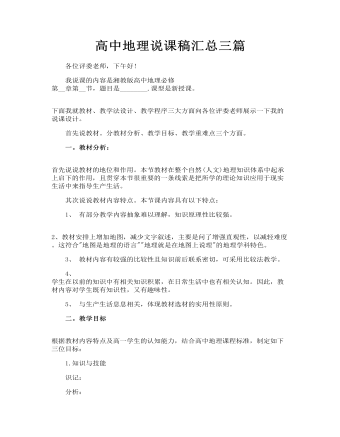
高中地理说课稿汇总三篇
一。教材分析: 首先说说教材的地位和作用。本节教材在整个自然(人文)地理知识体系中起承上启下的作用,且贯穿本节很重要的一条线索是把所学的理论知识应用于现实生活中来指导生产生活。 其次说说教材内容特点。本节课内容具有以下特点: 1、 有部分教学内容抽象难以理解,知识原理性比较强。 2、教材安排上增加地图,减少文字叙述,主要是问了增强直观性,以减轻难度。这符合"地图是地理的语言""地理就是在地图上说理"的地理学科特色。 3、 教材内容有较强的比较性且知识前后联系密切,可采用比较法教学。 4、 学生在以前的知识中有相关知识积累,在日常生活中也有相关认知。因此,教材内容对学生既有知识性,又有趣味性。
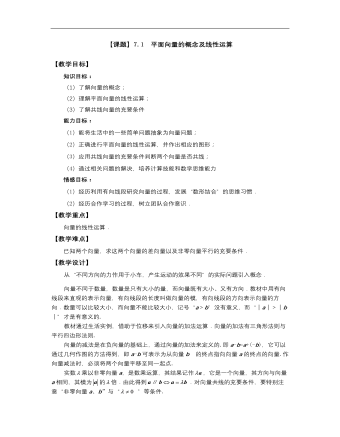
高教版中职数学基础模块下册:7.1《平面向量的概念及线性运算》教学设计
教 学 过 程教师 行为学生 行为教学 意图时间 *揭示课题 7.1 平面向量的概念及线性运算 *创设情境 兴趣导入 如图7-1所示,用100N①的力,按照不同的方向拉一辆车,效果一样吗? 图7-1 介绍 播放 课件 引导 分析 了解 观看 课件 思考 自我 分析 从实例出发使学生自然的走向知识点 0 3*动脑思考 探索新知 【新知识】 在数学与物理学中,有两种量.只有大小,没有方向的量叫做数量(标量),例如质量、时间、温度、面积、密度等.既有大小,又有方向的量叫做向量(矢量),例如力、速度、位移等. 我们经常用箭头来表示方向,带有方向的线段叫做有向线段.通常使用有向线段来表示向量.线段箭头的指向表示向量的方向,线段的长度表示向量的大小.如图7-2所示,有向线段的起点叫做平面向量的起点,有向线段的终点叫做平面向量的终点.以A为起点,B为终点的向量记作.也可以使用小写英文字母,印刷用黑体表示,记作a;手写时应在字母上面加箭头,记作. 图7-2 平面内的有向线段表示的向量称为平面向量. 向量的大小叫做向量的模.向量a, 的模依次记作,. 模为零的向量叫做零向量.记作0,零向量的方向是不确定的. 模为1的向量叫做单位向量. 总结 归纳 仔细 分析 讲解 关键 词语 思考 理解 记忆 带领 学生 分析 引导 式启 发学 生得 出结 果 10
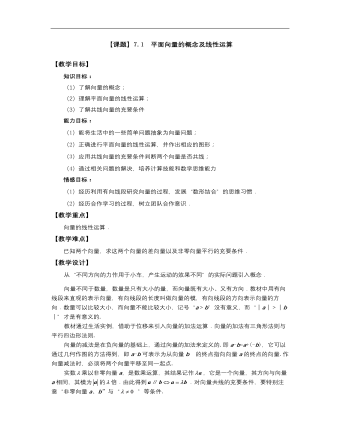
高教版中职数学基础模块下册:7.1《平面向量的概念及线性运算》教学设计
教 学 过 程教师 行为学生 行为教学 意图时间 *揭示课题 7.1 平面向量的概念及线性运算 *创设情境 兴趣导入 如图7-1所示,用100N①的力,按照不同的方向拉一辆车,效果一样吗? 图7-1 介绍 播放 课件 引导 分析 了解 观看 课件 思考 自我 分析 从实例出发使学生自然的走向知识点 0 3*动脑思考 探索新知 【新知识】 在数学与物理学中,有两种量.只有大小,没有方向的量叫做数量(标量),例如质量、时间、温度、面积、密度等.既有大小,又有方向的量叫做向量(矢量),例如力、速度、位移等. 我们经常用箭头来表示方向,带有方向的线段叫做有向线段.通常使用有向线段来表示向量.线段箭头的指向表示向量的方向,线段的长度表示向量的大小.如图7-2所示,有向线段的起点叫做平面向量的起点,有向线段的终点叫做平面向量的终点.以A为起点,B为终点的向量记作.也可以使用小写英文字母,印刷用黑体表示,记作a;手写时应在字母上面加箭头,记作. 图7-2 平面内的有向线段表示的向量称为平面向量. 向量的大小叫做向量的模.向量a, 的模依次记作,. 模为零的向量叫做零向量.记作0,零向量的方向是不确定的. 模为1的向量叫做单位向量. 总结 归纳 仔细 分析 讲解 关键 词语 思考 理解 记忆 带领 学生 分析 引导 式启 发学 生得 出结 果 10
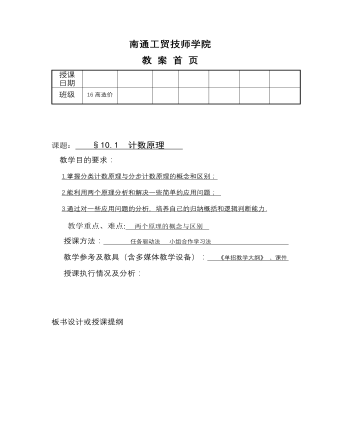
高教版中职数学基础模块下册:10.1《计数原理》教学设计
授课 日期 班级16高造价 课题: §10.1 计数原理 教学目的要求: 1.掌握分类计数原理与分步计数原理的概念和区别; 2.能利用两个原理分析和解决一些简单的应用问题; 3.通过对一些应用问题的分析,培养自己的归纳概括和逻辑判断能力. 教学重点、难点: 两个原理的概念与区别 授课方法: 任务驱动法 小组合作学习法 教学参考及教具(含多媒体教学设备): 《单招教学大纲》、课件 授课执行情况及分析: 板书设计或授课提纲 §10.1 计数原理 1、加法原理 2、乘法原理 3、两个原理的区别
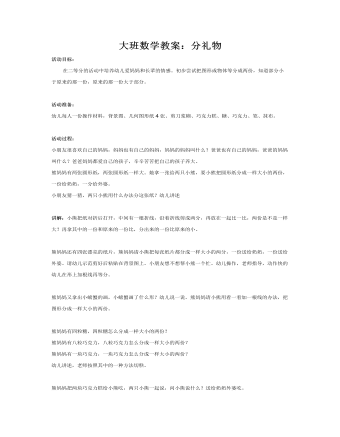
大班数学教案:分礼物
活动准备:幼儿每人一份操作材料,背景图、几何图形纸4张、剪刀浆糊、巧克力糕、糖、巧克力、笔、抹布。 活动过程:小朋友很喜欢自己的妈妈,妈妈也有自己的妈妈,妈妈的妈妈叫什么?爸爸也有自己的妈妈,爸爸的妈妈叫什么?爸爸妈妈都爱自己的孩子,辛辛苦苦把自己的孩子养大。熊妈妈有两张圆形纸,两张圆形纸一样大。她拿一张给两只小熊,要小熊把圆形纸分成一样大小的两份,一份给奶奶,一分给外婆。小朋友猜一猜,两只小熊用什么办法分这张纸?幼儿讲述
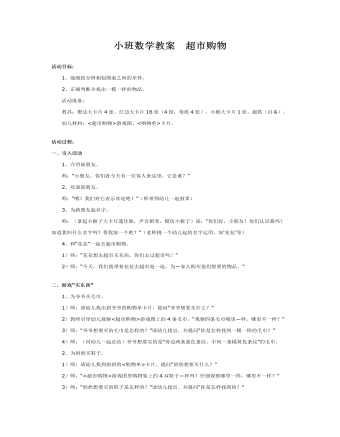
小班数学教案 超市购物
2、正确判断并找出一模一样的物品。 活动准备: 教具:橙边大卡片4张、红边大卡片16张(4组,每组4张)、小猴大卡片1张、磁铁(自备)。 幼儿材料:<超市购物>游戏图、<购物单>卡片。活动过程:一、引入活动 1、介绍新朋友。 师:“小朋友,你们看今天有一位客人来这里,它是谁?” 2、欢迎新朋友。 师:“哦!我们对它表示欢迎吧!”(师带领幼儿一起鼓掌) 3、为新朋友起名字。 师:(拿起小猴子大卡片遮住脸,声音稍变,模仿小猴子)说:“你们好,小朋友!你们认识我吗?知道我叫什么名字吗?帮我取一个吧?”(老师挑一个幼儿起的名字运用,如‘花花’等)
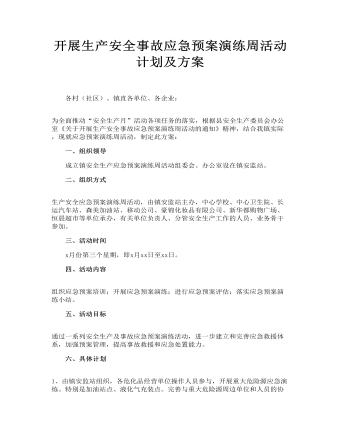
开展生产安全事故应急预案演练周活动计划及方案
二、组织方式 生产安全应急预案演练周活动,由镇安监站主办,中心学校、中心卫生院、长运汽车站、森美加油站、移动公司、豪锦化妆品有限公司、新华都购物广场、恒晨超市等单位承办,有关单位负责人、分管安全生产工作的人员、业务骨干参加。 三、活动时间 x月份第三个星期,即x月xx日至xx日。 四、活动内容 组织应急预案培训;开展应急预案演练;进行应急预案评估;落实应急预案演练小结。
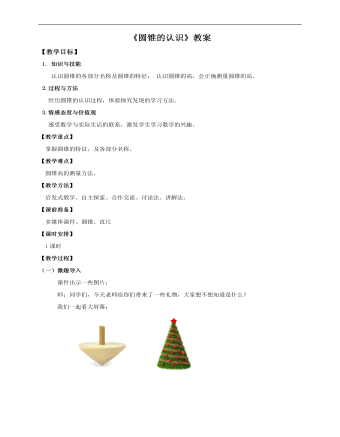
小学数学人教版六年级下册《第四课圆锥的认识》教案说课稿
2.过程与方法 经历圆锥的认识过程,体验探究发现的学习方法。3.情感态度与价值观 感受数学与实际生活的联系,激发学生学习数学的兴趣。【教学重点】 掌握圆锥的特征,及各部分名称。【教学难点】圆锥高的测量方法。【教学方法】启发式教学、自主探索、合作交流、讨论法、讲解法。【课前准备】多媒体课件、圆锥、直尺
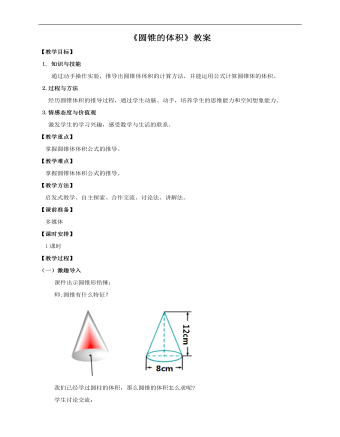
小学数学人教版六年级下册《第五课圆锥的体积》教案说课稿
(二)探究新知 1. 探究圆锥的体积的计算方法,学习例2。师:圆锥的体积和圆柱的体积有没有关系呢?圆柱的底面是圆,圆锥的底面也是圆……通过实验探究一下圆锥和圆柱体积之间的关系。小组合作探索:(1)各组准备好等底、等高的圆柱、圆锥形容器。(2)用倒沙子或水的方法试一试。(3)圆锥的体积与同它等底等 高的圆柱体积之间有什么关系?(4)小组活动,师巡视指导。2.推导圆锥体积的计算方法。 (1)课件演示等底等高的圆柱和圆锥

